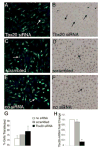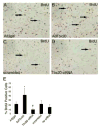Tbx20 regulation of endocardial cushion cell proliferation and extracellular matrix gene expression
- PMID: 17064679
- PMCID: PMC1847324
- DOI: 10.1016/j.ydbio.2006.09.047
Tbx20 regulation of endocardial cushion cell proliferation and extracellular matrix gene expression
Abstract
While recent work has implicated Tbx20 in myocardial maturation and proliferation, the role of Tbx20 in heart valve development remains relatively unknown. Tbx20 expression was manipulated in primary avian endocardial cells in order to elucidate its function in developing endocardial cushions. Tbx20 gain of function was achieved with a Tbx20-adenovirus, and endogenous Tbx20 expression was inhibited with Tbx20-specific siRNA in cultured endocardial cushion cells. With Tbx20 gain of function, the expression of chondroitin sulfate proteoglycans (CSPG), including aggrecan and versican, was decreased, while the expression of the matrix metalloproteinases (MMP) mmp9 and mmp13 was increased. Consistent results were observed with Tbx20 loss of function, where the expression of CSPG genes increased and MMP genes decreased. In addition, cushion mesenchyme proliferation increased with infection of a Tbx20-adenovirus and decreased with transfection of Tbx20-specfic siRNA. Furthermore, BMP2 treatment resulted in increased Tbx20 expression in endocardial cushion cells, and loss of Tbx20 led to increased Tbx2 and decreased N-myc gene expression. Taken together, these data support a role for Tbx20 in repressing extracellular matrix remodeling and promoting cell proliferation in mesenchymal valve precursor populations in endocardial cushions during embryonic development.
Figures








Similar articles
-
Twist1 function in endocardial cushion cell proliferation, migration, and differentiation during heart valve development.Dev Biol. 2008 May 1;317(1):282-95. doi: 10.1016/j.ydbio.2008.02.037. Epub 2008 Feb 29. Dev Biol. 2008. PMID: 18353304 Free PMC article.
-
Tbx20 acts upstream of Wnt signaling to regulate endocardial cushion formation and valve remodeling during mouse cardiogenesis.Development. 2013 Aug;140(15):3176-87. doi: 10.1242/dev.092502. Epub 2013 Jul 3. Development. 2013. PMID: 23824573 Free PMC article.
-
Expression and function of bone morphogenetic proteins in the development of the embryonic endocardial cushions.Anat Embryol (Berl). 2003 Sep;207(2):135-47. doi: 10.1007/s00429-003-0337-2. Epub 2003 Aug 1. Anat Embryol (Berl). 2003. PMID: 12905017
-
Molecular regulation of atrioventricular valvuloseptal morphogenesis.Circ Res. 1995 Jul;77(1):1-6. doi: 10.1161/01.res.77.1.1. Circ Res. 1995. PMID: 7788867 Review.
-
Tbx20, Smads, and the atrioventricular canal.Trends Cardiovasc Med. 2010 May;20(4):109-14. doi: 10.1016/j.tcm.2010.09.004. Trends Cardiovasc Med. 2010. PMID: 21335279 Review.
Cited by
-
Twist1 directly regulates genes that promote cell proliferation and migration in developing heart valves.PLoS One. 2011;6(12):e29758. doi: 10.1371/journal.pone.0029758. Epub 2011 Dec 29. PLoS One. 2011. PMID: 22242143 Free PMC article.
-
Myocardial Mycn is essential for mouse ventricular wall morphogenesis.Dev Biol. 2013 Jan 1;373(1):53-63. doi: 10.1016/j.ydbio.2012.10.005. Epub 2012 Oct 12. Dev Biol. 2013. PMID: 23063798 Free PMC article.
-
Endocardial Regulation of Cardiac Development.J Cardiovasc Dev Dis. 2022 Apr 19;9(5):122. doi: 10.3390/jcdd9050122. J Cardiovasc Dev Dis. 2022. PMID: 35621833 Free PMC article. Review.
-
Characterization of the novel interaction between muskelin and TBX20, a critical cardiogenic transcription factor.Biochem Biophys Res Commun. 2011 Jun 3;409(2):338-43. doi: 10.1016/j.bbrc.2011.05.020. Epub 2011 May 8. Biochem Biophys Res Commun. 2011. PMID: 21586270 Free PMC article.
-
A mouse model of conduction system patterning abnormalities in heterotaxy syndrome.Pediatr Res. 2010 Oct;68(4):275-80. doi: 10.1203/PDR.0b013e3181ee0028. Pediatr Res. 2010. PMID: 20581739 Free PMC article.
References
-
- Akhtar S, Meek KM, James V. Ultrastructure abnormalities in proteoglycans, collagen fibrils, and elastic fibers in normal and myxomatous mitral valve chordae tendineae. Cardiovasc Pathol. 1999;8:191–201. - PubMed
-
- Arciniegas E, Neves CY, Candelle D, Parada D. Differential versican isoforms and aggrecan expression in the chicken embryo aorta. Anat Rec A Discov Mol Cell Evol Biol. 2004;279:592–600. - PubMed
-
- Bailey M, Pillarisetti S, Jones P, Xiao H, Simionescu D, Vyavahare N. Involvement of matrix metalloproteinases and tenascin-C in elastin calcification. Cardiovasc Pathol. 2004;13:146–55. - PubMed
-
- Bartram U, Bartelings MM, Kramer HH, Gittenberger-de Groot AC. Congenital polyvalvular disease: a review. Pediatr Cardiol. 2001;22:93–101. - PubMed
Publication types
MeSH terms
Substances
Grants and funding
LinkOut - more resources
Full Text Sources
Molecular Biology Databases
Miscellaneous

